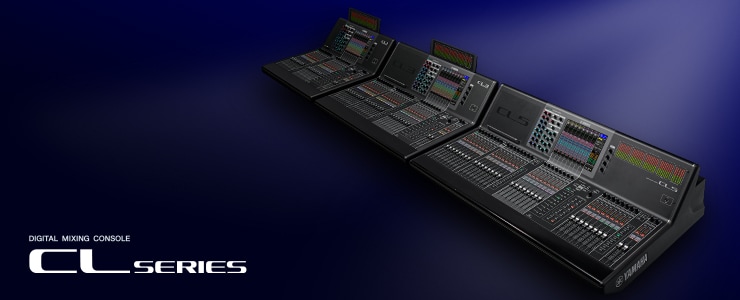CL V2.0 coming in May, with advanced control and expandability

March 12, 2014, Shizuoka, Japan – Yamaha’s CL series, the new industry standard, gains even more power and versatility in V2.0.
Based on the concept that “the standards stay, but innovation never ends,” the CL series digital mixing consoles have become industry standards. They offer groundbreaking refinements to highly regarded Yamaha operability while delivering outstanding sound quality throughout, including state-of-the-art Premium Rack processing. User Defined Knobs take control convenience to a new level, while Dante audio networking and live recording with Nuendo Live software define a new era of digital console capability.
Version 1.5 was released last March with Scene Preview plus discovery and patching for NEXO NXAMP Powered Digital TDcontrollers. Then in July, Version 1.6 introduced discovery and patching for Shure ULX-D Digital Wireless Systems. Version 1.7 was released in December, with new features that enhanced the console's suitability for complex applications such as festivals.
In addition to refinements that improve operation in live sound applications, Version 2.0 includes mix-minus capability for the broadcast market, broadening the range of applications where CL series performance can be advantageous. Another addition is discovery and head amp control for the simultaneously released compact QL consoles that inherit CL series features and performance. A QL console can function as both monitor mixer and I/O rack, for example, while a front-of-house CL console can remotely control the head amp gain of the QL console's I/O.
The CL V2.0 update will be available for download from the Yamaha Pro Audio website as of May 2014, and it will be free of charge.
Some of the new features provided with CL V2.0 are listed below:
New features with Version 2.0
 DCA Roll-Out
DCA Roll-Out
Channels assigned to DCA groups can be instantly called up to the console faders for enhanced operational flexibility. While operating the DCA faders in the Centralogic section, DCA Roll-Out can be used to call channels assigned to a specified DCA group up to the fader bank to the left of the Centralogic section, or conversely, the left fader bank can be used for DCA fader control while DCA Roll-Out brings the DCA channels up to the Centralogic section.
 Output DCA
Output DCA
The Stereo/Mono bus masters, Mix bus masters, and Matrix bus masters can be assigned to DCA groups. This means that in addition to conventional input channel grouping, DCA groups can be used for output master control as well. The extra control flexibility provided by this new feature can significantly improve overall workflow.
 Mix Minus
Mix Minus
Mix Minus, an important feature in broadcast applications, is now provided. With one simple operation the signal from a specified channel can be removed from a specified bus. This can be used to remove a reporter's location feed from a mix, for example.
 Read Only Scene Memory
Read Only Scene Memory
It is now possible to create read-only scene memories. The ability to specify read-only scenes provides extra data security by ensuring that those scenes will not be overwritten even when a console file is loaded.
 Daisy Chain Insert
Daisy Chain Insert
Two devices can now be inserted into one channel or bus for enhanced processing freedom. This makes it possible to create process chains such as a Portico 5033 equalizer followed by an Open Deck simulation, or an MY8-LAKE (Mesa EQ) processor followed by a Portico 5043 compressor/limiter, for example.
 GR Meter Option on Channel Name Display
GR Meter Option on Channel Name Display
It is now possible to show the Dynamics 1 and Dynamics 2 gain reduction meters in the channel name display. This makes gain reduction status visible even when the Overview or Selected Channel display is not showing. Channel encoder value or gain reduction display can be selected via the preferences.
 AG to DG Link Option for Gain Compensation
AG to DG Link Option for Gain Compensation
Analog gain control can be linked to digital gain within the console when Gain Compensation is engaged. Local analog gain adjustments made with the Link function enabled affect console gain in the conventional way, while the Gain Compensation function maintains constant gain levels at other consoles so unexpected gain changes won't disrupt the program.
Chihaya "Chick" Hirai, Yamaha Pro Audio PA department manager comments: “CL V2.0 not only adds new features that are also included in the simultaneously released QL series consoles, but it also adds support for the broadcast market with Mix Minus functionality that is particularly important for relay broadcasts. With this update the CL series offers added operational convenience for broadcast applications, while also gaining significant system expansion capability through functional integration with the new QL series consoles. We will also be adding built-in Dugan automatic mixing as introduced in the QL series, plus additional support for broadcast applications to the CL series. Yamaha will continue to keep a close eye on the market in order to provide features and performance that will be of maximum value to our customers.”
*Product and company names and logos that appear in this news release are trademarks of their respective owners.
